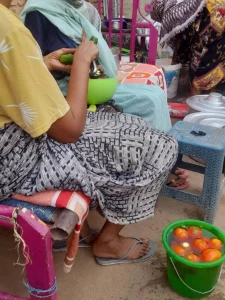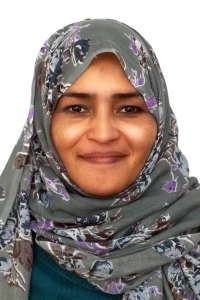Local leadership is what it took to make a CVA breakthrough in Sudan
When it came to the cash distribution in Sudan, local actors’ understanding of the target neighbourhood contexts and fast changing dynamics were central to success. Without local leadership there would have been no way forward for effective cash programming in Khartoum. NIDAA’s Sara Elgieli and CORE’s Tenzin Manell unpack their recipe for success and the 4 key ingredients needed.

Sudan context – a massive crisis
Sudan is currently home to the highest number of internally displaced people (IDPs) in the world yet is receiving limited humanitarian assistance — far less than other countries affected by armed conflict, such as Ukraine and Syria.
Conflict-affected households in Khartoum State are particularly underserved with a dearth of international organizations willing to navigate the fluid context and donors slow to deliver on their commitments. It’s local actors who are leading the way and who have already proven their capacity to deliver cash assistance in Khartoum despite the challenging operational context. Lessons learned provide real and tangible approaches to pave the way for Cash and Voucher Assistance (CVA) at scale in Khartoum, and lessons for wider reflection globally.
On April 15th, 2023, conflict erupted in Sudan resulting in widespread displacement, including 8 million IDPs, and more than 25 million people in critical need of assistance. Today, food insecurity has already reached alarming levels, the healthcare system has crumbled and communicable diseases, including cholera, are running rampant. The ongoing fighting between the Sudan Armed Forces (SAF) and the Rapid Support Forces (RSF) which began in Khartoum has spread across the country. Ongoing humanitarian access issues, as well as limited funding, have limited external support. Meantime, grassroots local volunteers have formed Emergency Response Rooms (ERRs), with satellite Women’s Response Rooms (WRRs), and have become the main avenue for assistance provision in Khartoum alongside a few remaining local organizations working to support the population.
 Successful CVA – a locally-led response was the breakthrough for getting multi-purpose cash assistance (MPCA) to households encircled by the conflict. Together with Financial Service Provider partners, NIDAA and CORE broke through with the first delivery of cash in Khartoum to 600 households in July 2023. The two agencies built an alliance grounded in mutual learning and dialogue which positioned NIDAA as the compass to follow. For example, it was NIDAA’s team who knew the importance of blanket targeting to mitigate risks for cash recipients and humanitarian staff alike. Trying to target based on vulnerability is not only tone-deaf but ineffective, given that all who remain in Khartoum are now vulnerable. Given the duration and intensity of the conflict those sheltering in one place or moving from neighborhood to neighborhood seeking safety – have universally been selling off assets, reducing food intake, and have been unable to access healthcare, including for chronic health issues. What’s more, cultural and religious norms of mutual aid would have meant assistance would have been redistributed in any case, to make sure that all had some.
Successful CVA – a locally-led response was the breakthrough for getting multi-purpose cash assistance (MPCA) to households encircled by the conflict. Together with Financial Service Provider partners, NIDAA and CORE broke through with the first delivery of cash in Khartoum to 600 households in July 2023. The two agencies built an alliance grounded in mutual learning and dialogue which positioned NIDAA as the compass to follow. For example, it was NIDAA’s team who knew the importance of blanket targeting to mitigate risks for cash recipients and humanitarian staff alike. Trying to target based on vulnerability is not only tone-deaf but ineffective, given that all who remain in Khartoum are now vulnerable. Given the duration and intensity of the conflict those sheltering in one place or moving from neighborhood to neighborhood seeking safety – have universally been selling off assets, reducing food intake, and have been unable to access healthcare, including for chronic health issues. What’s more, cultural and religious norms of mutual aid would have meant assistance would have been redistributed in any case, to make sure that all had some.
When it came to the cash distribution, in partnership with RedRose and Cashi, NIDAA’s contributions to troubleshooting the proximity between the Cashi merchant locations and recipients, as well as understanding the target neighborhood contexts and kinetics were central to success. It was the local community and NIDAA’s team who advocated for expanding the number of Cashi merchants to reduce the distance for collection, with the added benefit of diversifying income streams for neighborhood vendors as they joined the Cashi network. And again, it was the local community and NIDAA’s team who nudged partners to test digital wallets as a parallel delivery mechanism to offer recipients and implementing partners flexibility. CORE knew to listen, follow, help problem-solve, pivot and adapt, and backstop. Without local leadership there is no way forward for cash in Khartoum.
The recipe for success – key ingredients
The recipe for successful implementation has been equitable partnership, risk sharing, piloting and adaptation, and embracing the complementarity of MPCA and group cash transfers to address gaps in services.
1. Equitable partnership
Local actors, including the ERRs, are ready for equitable partnership. International actors need to dive in ready to truly act with mutual trust, respect, transparency, and flexibility and ensure a fair share of effort and resources. International actors need to show up to backstop local experts and do-ers, not to add to the obstacles that local actors are already facing and overcoming as front-line responders.
2. Risk sharing
During a momentous ERR envoy to New York and Washington, D.C. in late January the message was clear: unless there is a greater threshold for risk, and risk-sharing among international and local actors, lives will unnecessarily be lost. Donors and many international actors continue to be stuck in the quicksand of compliance and have largely been apprehensive and sluggish to deliver on their commitments on localization globally and in Sudan in particular. Accountability is critical, yet bending the arc of expectations away from heavy requirements among donors and international actors and towards what is feasible for the ERRs requires a middle path with greater flexibility in procedures and formats. ERRs have shown in their partnership with NIDAA and CORE that they can deliver financial and narrative reporting with some pointers on data quality and patience in the face of connectivity issues.
3. Learning, adapting and sharing
Piloting, adapting, documenting and sharing lessons is key, and already taking place. Moving forward incrementally allows for testing and sharing to figure out how it IS possible to reach households with lifesaving assistance, despite the context being fluid. NIDAA and CORE selected two neighborhoods for the MPCA pilot in Khartoum; one is a largely static population while the other is displaced, thereby affording greater learning. Diligently working with RedRose and Cashi, we were able to test multiple approaches to cash collection – including bulk collection, remote collection, localized-relationship-based collection, in order to determine which strategies were the safest and most feasible for recipients, staff and FSPs.
4. Deploying multiple CVA solutions
Using Group Cash Transfers (GCT) in parallel to MPCA helped stretch resources to cover gaps in services. This combination has proven to be an effective and cost-efficient combination, meeting households’ basic needs and making available and accessible community-identified solutions to the challenges communities are facing, which together enable broader type and coverage of services. The complementarity of MPCA and GCT is particularly clear when it comes to addressing gaps in services for marginalized groups, including women and children. In parallel to MPCA, GCT were used to support 11 of the WRRs to scale up and expand upon their activities providing life-saving support across Khartoum. With a support package of group cash transfers and training, the WRRs carried out health, protection, psychosocial support and nutrition activities targeting women and children, which complemented MPCA.
It’s time to walk the talk
Without the local leadership of the WRRs – in both their vision and execution of community-identified solutions to community-identified needs – there would not have been the myriad of GCT outcomes which complemented MPCA: safe relocation of women activities and individuals at risk of Gender-Based Violence (GBV) as well as GBV survivors; safe births/deliveries by transferring women in labor to clinics inside and outside of Khartoum to access life-saving medication and operations; referral pathways for health, protection and psychosocial support services; women’s and children’s safe spaces; and communal kitchens.
International actors do not need to reinvent the wheel. There are already documented lessons learned from locally led Cash and Voucher Assistance that should be taken forward. In doing so, vast unmet needs that communities are facing right now can be addressed.
Well into a decade of localization commitments, action is thin. Aren’t we all tired of not walking the talk? Let’s walk the talk on CVA and localization now in Sudan – and around the world – and in doing so, we will implement higher quality programming and save more lives.
Authors

Sara Elgieli is Executive Manager at Sudanese Development Call Organization (NIDAA), a Sudan-based non-governmental organization that aims to serve, mobilize and motivate Sudanese society longing for desirable change through training, advocacy and sustainable community development. To learn more visit www.nidaa.org and contact Sara (sara.elgieli@nidaa.org).

Tenzin Manell is Sr. Advisor for Cash and Markets at Community Organized Relief Effort (CORE), an international non-governmental organization that aims to empower communities in and beyond crisis towards a more equitable world in which underserved communities are prepared and can respond effectively to crisis from within. To learn more visit www.coreresponse.org and contact Tenzin (tenzin.manell@coreresponse.org).
In the cover image: Florence Joan Joseph, 45, mother of 6 children. Florence was one of the women beneficiaries to receive a cash grant assistance to boost their livelihoods. The South Sudan Red Cross gave her a grant of about 248,000 SSP and she decided to start her new business venture as a trader of fruit and vegetables. ©Anne Wanjiru, IFRC/2023.


